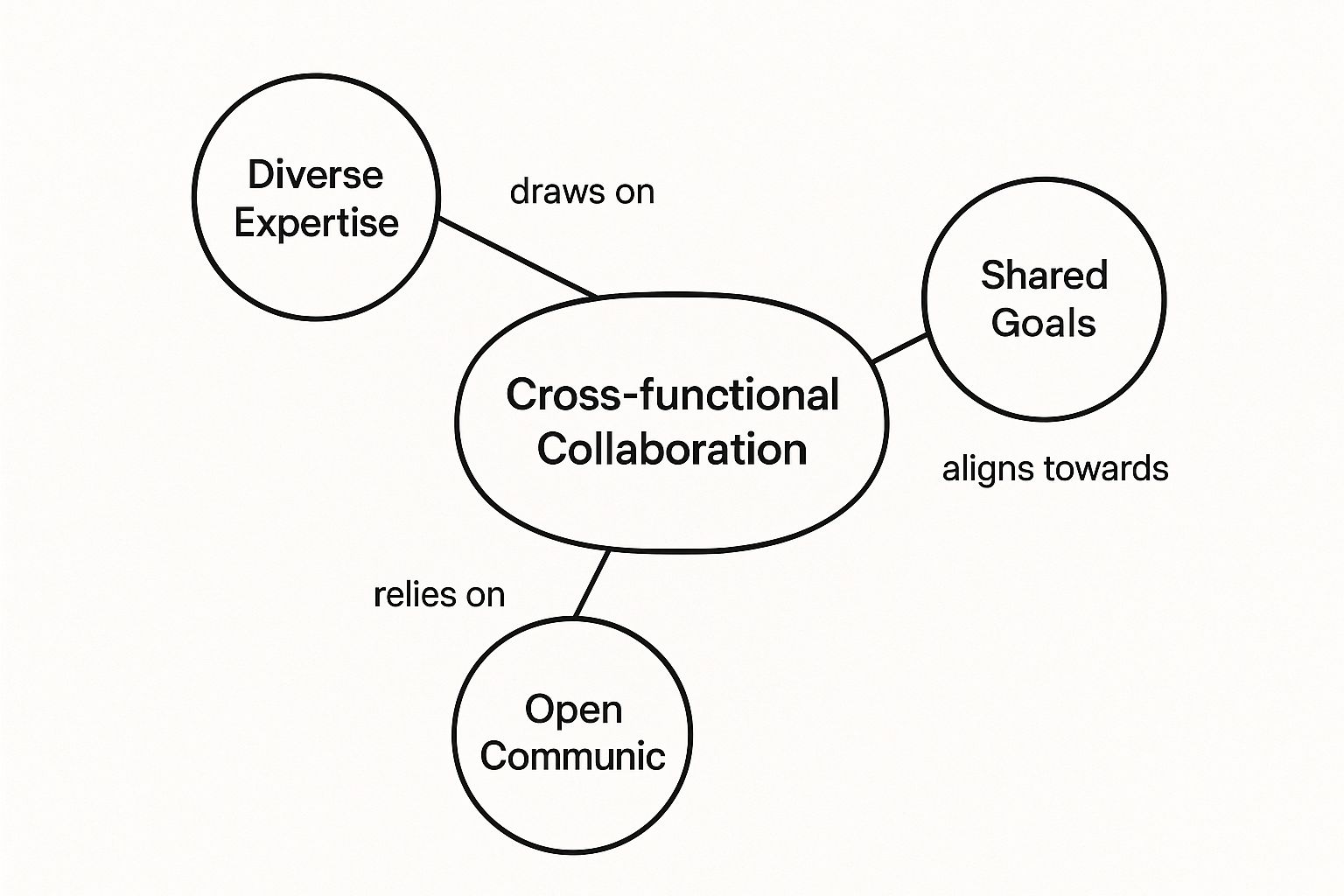What Is Cross Functional Collaboration? Unlock Team Success
When you get people from different departments—think engineering, marketing, sales, and product—to roll up their sleeves and tackle a project together, you've got cross-functional collaboration. It's all about breaking down the invisible walls between teams to pool together diverse skills and perspectives. The result? Faster problem-solving and much better outcomes for the business.
Decoding Cross Functional Collaboration
Let's get past the business buzzwords. Picture building a brand-new car. You wouldn’t want the engine team working in a vacuum, completely separate from the chassis designers or the folks wiring the electronics. Real innovation sparks when everyone is in the room from the get-go, sharing ideas and hitting roadblocks as one unit. That, in a nutshell, is what cross functional collaboration is all about.
This isn't just about grabbing coffee with people from other departments. It’s a deliberate, structured approach to work. In a classic top-down, siloed company, information gets stuck moving up and down one functional ladder. When it’s finally time for a handoff to another department, you get bottlenecks, delays, and a whole lot of "I thought you were handling that."
A cross-functional team is like a Swiss Army knife. Each tool has a specific job, but its real power comes from having all of them together in one place, ready to solve whatever problem comes your way.
The Core Components of Collaboration
This way of working completely flips the old model on its head. Forget the relay race, where one team finishes their part and passes the baton to the next. This is more like a basketball team. Everyone is on the court at the same time, passing the ball, communicating constantly, and adjusting the game plan on the fly.
This approach stands on three core pillars: diverse expertise, shared goals, and wide-open communication.

As you can see, if you pull out any one of those pillars—be it the different skills, a common objective, or honest dialogue—the whole thing starts to wobble. Each piece is absolutely critical for the structure to hold.
From Silos to Synergy
To understand the impact of this shift, it helps to see the two models side-by-side. The differences in how teams operate, communicate, and ultimately perform are stark.
Siloed Teams vs Cross Functional Teams at a Glance
| Characteristic | Siloed Teams | Cross Functional Teams |
|---|---|---|
| Structure | Hierarchical, organized by function (e.g., Marketing Dept). | Flat, organized around a project or goal. |
| Communication | Top-down; information flows within the department. | Open and horizontal; information flows freely across functions. |
| Focus | Departmental KPIs and individual tasks. | A single, shared project objective. |
| Ownership | Individual accountability for a specific part of the process. | Collective ownership of the final outcome. |
| Decision-Making | Slow, often requires escalation up the chain of command. | Fast and agile, made by the team closest to the work. |
| Innovation | Limited by the perspective of a single department. | Fueled by diverse viewpoints and creative friction. |
Making the jump from isolated departments to truly integrated teams is more than just rearranging an org chart; it’s a fundamental cultural shift. It asks people to expand their loyalty from just their immediate team to the project's overarching mission.
And the data shows it's worth it. Studies have found that companies that champion cross-functional teamwork can be 30% more productive than their siloed counterparts. On top of that, organizations with strong collaboration see a 41% increase in customer satisfaction, because they’re building solutions that actually address the full scope of a customer's needs. You can dig deeper into these collaborative performance findings on Teamhood.com.
At the end of the day, true cross-functional collaboration boils down to three key things:
- Diverse Skill Sets: Teams are built on purpose with a mix of specialists—like a developer, a marketer, a designer, and a data analyst all working on the same squad.
- Shared Ownership: The entire team sinks or swims together. They're collectively on the hook for the result, not just their little piece of the puzzle.
- Unified Goal: Everyone is pulling in the same direction toward a clearly defined objective that matters more than any single department's individual targets.
The Real Business Impact of Working Together
It’s one thing to talk about cross-functional collaboration in theory, but what really matters is seeing the impact on the bottom line. When you get different minds, skill sets, and perspectives working together, the results aren't just a fuzzy feeling of teamwork—they're tangible business advantages that ripple across the entire company. Think of it less as a management trend and more as a strategic lever for real growth.

This way of working is a powerful engine for innovation. When teams are siloed, they naturally develop tunnel vision, focusing only on their little piece of the puzzle. A cross-functional team blows those walls down, creating a space where different viewpoints can productively collide.
Sparking True Innovation
Innovation rarely happens in a vacuum. It sparks to life at the intersection where different disciplines meet. When a software engineer’s deep understanding of what’s technically possible runs into a marketer’s sharp instinct for what a customer actually wants, that's where the magic happens.
Toss a customer support specialist into that mix—someone who hears about user pain points all day, every day—and you don't just build a better product. You build the right product. This fusion of perspectives helps you sidestep costly mistakes and ensures the thing you build solves a real market need, not just an internal assumption.
And it does it all much, much faster.
By getting all the necessary skills in the room from the very beginning, cross-functional teams can slash product development cycles by up to 20%. In today's market, that speed isn't just nice to have; it's a critical competitive advantage.
Accelerating Decision-Making
We’ve all seen it: the classic corporate structure that’s bogged down by red tape. An idea from one department has to slowly crawl up the chain of command, get passed over to another department, and then trickle back down. Every single step adds delay and opens the door for miscommunication.
Cross-functional teams completely flatten this structure. With all the key players already in the same room (whether physical or virtual), decisions can happen right then and there. That agility is what keeps projects moving forward, on schedule, and within budget.
Instead of waiting days for an approval, the team can pivot in a single meeting. This rapid feedback loop doesn't just save a ton of time; it also produces better results because you're making adjustments based on real-time input from every corner of the project.
Building a More Engaged Workforce
Working this way is also a secret weapon for professional development. When employees are constantly rubbing shoulders with colleagues from other departments, they can't help but soak up new skills and get a much wider view of the business. An engineer starts to understand market positioning. A salesperson gets a peek behind the curtain of the product development lifecycle.
This cross-pollination of knowledge creates a more versatile and capable workforce. More than that, it's a huge boost for employee engagement and retention. People feel a deeper connection to the company's mission when they can see exactly how their day-to-day work fits into the bigger picture.
- Deeper Ownership: Team members feel a much stronger sense of accountability for a project's outcome because they’ve been part of it from start to finish.
- Skill Expansion: You start to see more T-shaped employees—people with deep expertise in their main role, balanced by a broad understanding of how other functions work.
- Higher Morale: There’s a sense of camaraderie that comes from working together toward a common goal, a feeling that’s often missing in the isolated world of siloed work.
Enhancing the Customer Experience
At the end of the day, the biggest winner in all of this is the customer. When your internal teams work in isolation, the customer journey often feels disjointed and clunky. The marketing message might not quite match the product’s actual features, or the customer support experience feels totally disconnected from the sales process.
A cross-functional approach smooths out all those rough edges, creating a single, seamless experience. Imagine a SaaS company forming a team with folks from product, marketing, and customer success, all focused on one goal: reducing customer onboarding time. By tackling it together, they can build a unified process that eliminates friction, clarifies the product's value, and sets new users up for success from day one.
This holistic view is what turns a collection of disjointed features into a coherent, valuable solution—and that's what builds real customer satisfaction and loyalty.
Here is the rewritten section, designed to sound natural and human-written by an experienced expert.
Navigating the Common Collaboration Roadblocks
Let's be honest: for all the talk about its benefits, getting cross-functional collaboration right is tough. It’s not about flipping a switch and watching the magic happen. More often than not, it shines a spotlight on all the little friction points that were neatly hidden away inside departmental walls.
Seeing these roadblocks isn't a sign you're failing. It’s a sign you're growing. These are the predictable growing pains that pop up when different working styles, priorities, and communication habits finally have to mix. The trick is to see them coming and have a plan to smooth things over before they grind your project to a halt.
The Challenge of Competing Priorities
One of the first and most common hurdles you'll hit is the classic clash of departmental goals. The marketing team has their eye on lead generation, the product team is laser-focused on shipping new features, and the sales team lives and breathes closed deals. When you pull them into a room together, their individual KPIs can act like magnets repelling each other.
Imagine a marketer pushing for a splashy new feature that will create a ton of buzz, while an engineer argues for a quiet, behind-the-scenes backend update to improve stability. Neither of them is wrong, but their priorities are in a dead heat. This is how you end up in a stalemate, with everyone digging in to defend their own turf while the shared project languishes.
The silo mentality isn't just about hoarding information; it's about defending departmental objectives. True collaboration requires shifting allegiance from "my team's goals" to "our project's outcome."
The way out of this is to give everyone a single, shared finish line to run toward. Frameworks like Objectives and Key Results (OKRs) are perfect for this. By creating one big-picture project OKR that everyone contributes to, you give the entire team a North Star. Suddenly, the marketing team’s key result directly feeds the product team’s success, and everyone starts rowing in the same direction.
Overcoming Communication Disconnects
Every department speaks its own language. It’s a natural shorthand filled with acronyms, jargon, and technical terms that make perfect sense internally but sound like gibberish to anyone else. When a product manager starts talking about "sprint velocity" and "story points," a sales exec focused on "MRR" and "churn rates" might as well be listening to a foreign language.
This communication gap is a breeding ground for misunderstandings. Assumptions rush in to fill the void left by unclear language, leading to misaligned work and a lot of wasted time. And it’s not just the words—it’s the tools. If engineering lives in Jira while marketing runs on Asana, you’ve created information black holes that nothing can escape.
To bridge this gap, you have to be intentional about creating a shared communication toolkit.
- Establish a Project Glossary: Kick off the project by creating a simple, shared document. Define all the key terms and acronyms that will be used, so everyone is on the same page from day one.
- Centralize Communication: Pick one place for all project talk. Whether it’s a dedicated channel in Slack or Microsoft Teams, this ensures no one misses a key conversation.
- Standardize Documentation: Use a central hub like Confluence or Notion for everything from the initial brief to the final report. This makes information transparent and easy for anyone to find.
The Persistent Silo Mentality
Maybe the toughest nut to crack is the silo mentality—that deep-seated "us vs. them" instinct where teams guard their knowledge, resources, and turf. This isn’t because people are difficult; it's often a side effect of old-school company structures that reward individual department wins over collective success. Teams get protective of their data or shy away from sharing early ideas for fear of being judged.
This gets even harder when everyone is working from different locations. In fact, strengthening team cohesion is a crucial part of learning how to manage remote teams effectively. Breaking down these invisible walls comes down to one thing: trust.
Leaders have to set the tone by actively modeling and rewarding collaboration. Celebrate shared wins publicly. Frame failures as collective learning moments, not opportunities to point fingers. When people feel psychologically safe, they're willing to be vulnerable, share half-baked ideas, and offer feedback freely. That’s the real foundation of great cross-functional work.
How Successful Companies Make Collaboration Work
It’s one thing to talk about cross-functional collaboration in theory, but seeing it in practice is where the real lightbulbs go off. The most successful companies don’t just pay lip service to breaking down silos; they build deliberate systems that weave different teams together, all pulling toward the same goal.
Let's unpack how two completely different organizations—a pharma giant in a heavily regulated field and a disruptive tech leader—make collaboration their secret weapon.

These real-world examples give us a blueprint for turning abstract ideas about teamwork into tangible business outcomes. They prove that while the exact model might differ, the core principles of shared ownership and constant communication never change.
Pharma: From Lab Bench to Market Launch
Getting a new drug to market is an unbelievably complex marathon where a single dropped baton can have massive consequences. This makes pharma a perfect case study for collaboration that isn't just a "nice-to-have"—it's a regulatory mandate. Three key teams have to move in lockstep: Marketing, Research & Development (R&D), and Medical Affairs.
Right out of the gate, their priorities are often miles apart. R&D lives and breathes clinical data and scientific integrity. Marketing is focused on shaping a powerful message that resonates with doctors and patients. And Medical Affairs acts as the guardian of compliance, making sure every single claim is legally and ethically airtight. When these teams work in isolation, you get delayed launches, confusing messaging, and sometimes even regulatory fines.
A winning launch team flips this script by forming a unified project group from day one.
- The Initial Problem: A massive disconnect exists between the clinical evidence (R&D), the story being told to the market (Marketing), and the rules of engagement (Medical Affairs). This creates bottlenecks and major risks.
- The Collaborative Structure: A dedicated launch team is created with leaders from each function. They all work from a single project charter, united by one clear goal: a successful and compliant launch.
- The Measurable Result: This integrated approach consistently leads to faster regulatory submissions, a stronger and more unified brand message, and higher adoption rates from healthcare providers.
Make no mistake, poor collaboration is a known performance killer in this industry. In fact, some studies show that 60% of underperforming pharmaceutical sales teams point directly to weak collaboration as a reason for their struggles. This just underscores how critical it is to have a model where marketing claims are directly shaped by clinical data and signed off by compliance in real-time. You can dig deeper into this winning formula for pharma collaboration on medicalaffairsspecialist.org.
Spotify and the Power of Autonomous Squads
Spotify famously cracked the code on scaling agile development by designing a unique organizational structure that champions both autonomy and shared knowledge. Instead of traditional departments, they built their organization around what they call Squads, Chapters, and Guilds. It’s a masterclass in what modern, cross-functional teamwork can look like in a fast-paced tech company.
A Squad is the core unit. Think of it as a tiny startup within the larger company—a small, self-sufficient, cross-functional team that has complete ownership over a specific feature, like the search function or the playlist creator. Each Squad has every skill it needs—engineering, design, product management—to build, test, and ship its feature all on its own.
But how do you keep specialists from becoming isolated and ensure their skills stay sharp? That’s where Chapters come in.
Chapters are the glue that holds specialists together. A Chapter is a group of people with the same skillset (like all the UX designers) who are spread across different Squads. They meet regularly to swap ideas, solve common problems, and keep the standards for their craft incredibly high.
Finally, Guilds are informal, company-wide communities built around a shared interest. Anyone from any Squad or Chapter can join a Guild to nerd out on a topic they’re passionate about, whether it’s a new programming language, accessibility design, or machine learning. This structure truly gives Spotify the best of both worlds: the speed and focus of an autonomous Squad combined with the deep expertise you’d find in a traditional department.
A Blueprint for Building High-Performing Teams
Knowing the theory is one thing, but actually building a lasting culture of cross-functional collaboration? That takes a practical, step-by-step approach. It's all about creating an environment where teamwork isn't just a buzzword—it's the default way of getting things done. This blueprint lays out the essential pillars for putting together teams that are not only high-performing but also resilient and adaptable.

Let's be clear: this isn't about a one-off workshop or a new initiative. It's an ongoing commitment to aligning people, clarifying roles, and nurturing an atmosphere where great ideas can truly come from anywhere.
Establish a Powerful Shared Vision
Before a single task is assigned, the entire team has to be united by a single, compelling "why." A shared vision is the North Star that guides every decision. It ensures that even when departmental priorities start to pull in different directions, everyone is still rowing the same way.
This vision needs to be more than just a vague project goal; it has to be a crystal-clear picture of the desired outcome and its real-world impact. A truly powerful vision answers three critical questions for every single person on the team:
- What are we building? A no-nonsense definition of the end goal.
- Why does it matter? The impact this project will have on both the customer and the business.
- How will we measure success? The specific, concrete metrics that define a win.
When this vision is clear and constantly reinforced, it becomes the ultimate tiebreaker in any debate. The conversation shifts from "my team needs this" to "what gets us closer to our shared goal?"
Define Roles and Foster Accountability
Ambiguity is the absolute enemy of collaboration. When roles are fuzzy, tasks get dropped, work gets duplicated, and frustration skyrockets. Defining who is responsible for what isn't optional—it's essential.
One of the most effective tools for bringing this clarity is a RACI matrix. It’s a simple chart that spells out each team member’s role for any given task or decision.
A RACI chart clarifies who is:
- Responsible: The person (or people) actually doing the work.
- Accountable: The one individual who ultimately owns the final outcome.
- Consulted: The subject matter experts who provide input and advice.
- Informed: The people who just need to be kept in the loop on progress.
This simple framework cuts through the confusion and builds a culture of ownership. Everyone knows exactly what's expected of them and who to go to for decisions, which is a huge part of learning how to increase team productivity.
Cultivate Psychological Safety
The best, most innovative ideas often come from a place of vulnerability—from someone being willing to ask a "dumb" question, challenge the status quo, or throw out a wild idea. This can only happen in an environment of psychological safety, where people feel secure enough to take these kinds of interpersonal risks without fear of being shut down or ridiculed.
Psychological safety isn’t about just being nice. It’s about creating a candid environment where people can speak up, share honest feedback, and admit mistakes, knowing the team has their back. It is the single most important dynamic found in high-performing teams.
Leaders play a massive role here by modeling curiosity, admitting their own mistakes, and actively encouraging input from the quieter members of the group. For a deeper dive, check out this guide on building high-performing teams to create an environment where collaboration can truly flourish.
Adapt for Remote and Hybrid Work
With so many teams now distributed, there's another layer of complexity to consider. As of 2023, 12.7% of full-time employees work entirely from home, and another 28.2% are in hybrid setups. This isn't a passing trend, so it's critical to adapt your collaborative practices for a world that doesn't always share an office.
To make cross-functional collaboration work remotely, you have to be twice as intentional about your communication and tools. It's about creating a digital headquarters—a single source of truth where all project information lives and breathes.
- Communication Hubs: Use tools like Slack or Microsoft Teams for real-time conversation and quick check-ins.
- Project Management Platforms: Systems like Asana, Trello, or Jira are essential for tracking tasks and progress transparently.
- Documentation Centers: Create centralized wikis in Confluence or Notion to house all project-related knowledge, so no one is ever out of the loop.
By picking the right tools and setting clear rules of engagement, you can replicate the spontaneous energy of an office and ensure everyone stays aligned, no matter where they’re logging in from.
Answering Your Key Collaboration Questions
As you start to put these ideas into action, theory quickly gives way to reality. Moving from the "why" of cross-functional collaboration to the "how" is where things get interesting. This is where the practical, on-the-ground questions pop up.
Think of this section as your FAQ for the day-to-day challenges of making these teams actually work.
How Do You Actually Measure Success?
One of the first hurdles is realizing that "on time and on budget" just doesn't cut it anymore. While those old-school metrics still matter, they don't tell you the whole story. Real success isn't just about output; it's about the outcome and the overall health of the team that produced it.
To get the full picture, you need to look at a mix of hard numbers and softer, human-centric indicators.
- Innovation Velocity: How fast can the team go from a spark of an idea to something customers can actually interact with? A quick velocity usually signals that you've eliminated a lot of internal red tape and everyone is on the same page.
- Team Health Scores: This is crucial. Use quick, anonymous surveys to get a read on morale, trust, and psychological safety. Can people speak up and challenge ideas without fear? Do they feel like their teammates from other departments have their back?
- Customer Impact Metrics: Don't just celebrate shipping a feature. Measure what happened after. Did it actually reduce support tickets? Did user retention tick up? Did customer satisfaction scores improve?
The true test of a cross-functional team isn't just what they delivered, but the value it created. A project that’s on time but solves the wrong problem isn't a win.
Of course, measuring success also means tracking the financial return. When a team streamlines a process or launches a hit product, the impact can be huge. To connect those dots, it’s helpful to understand how to calculate return on investment and apply that thinking to your team’s projects.
What Is the Ideal Size for a Cross-Functional Team?
Team size is a classic balancing act. You need enough brainpower to cover all the skills, but not so many people that you get bogged down in endless meetings and slow decision-making.
This is where you've probably heard of Amazon's famous "two-pizza rule."
The concept is brilliantly simple: a team should never be so large that you can't feed them with two pizzas. In practice, that usually means a team of about 5 to 9 people. This range is widely seen as the sweet spot for keeping things nimble while still having a diversity of expertise.
Here’s the push and pull you’re managing:
- Smaller Teams (3-5 people): These crews are incredibly fast. Communication is almost instant, and they can turn on a dime. The risk? They might lack a key skill or get overwhelmed if the project's scope suddenly balloons.
- Larger Teams (10+ people): You can pack a ton of expertise into a larger group. But the communication overhead grows exponentially, decision-making slows to a crawl, and you run the risk of "social loafing"—where some folks hang back and let others do the heavy lifting.
For most initiatives, sticking to that 7 +/- 2 range gives you the best of both worlds. It's big enough for a rich mix of talent but small enough to stay agile and focused.
How Does a Leader's Role Change in This Model?
This is probably the biggest shift of all, and it falls squarely on the leader. The traditional, top-down manager who doles out tasks and checks boxes is a liability in a cross-functional setup. The role has to evolve into something much more like a coach or a facilitator.
Instead of having all the answers, a modern leader's job is to ask the right questions. Their primary function is no longer to direct, but to empower.
This really boils down to three key shifts in mindset:
- From Director to Obstacle Remover: Your main job is to run interference. Clear the path so the team can do their best work. That might mean fighting for a budget, shielding them from corporate distractions, or navigating tricky internal politics.
- From Expert to Facilitator: You don't have to be the smartest person in the room on every topic. Your role is to guide the conversation, make sure every voice is heard, and help the team find its own answers. You trust the specialists to own their domains.
- From Micromanager to Vision Keeper: The leader is the guardian of the "why." You are constantly connecting the team's day-to-day work back to the bigger picture, keeping everyone aligned, motivated, and focused on the ultimate goal.
It’s a huge change that requires a lot of humility and trust. A leader's success is no longer defined by their individual output, but by the autonomy and success of the team they serve.
Ready to eliminate the bottlenecks and build truly collaborative, high-performing teams in your business? MakeAutomation specializes in creating the automated systems and streamlined SOPs that allow cross-functional work to flourish. Book a discovery call today and let's design the workflows that will power your growth.







